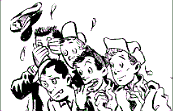
Move to Headcorn
379th Journal, Volume IV, April - May 1944
Click on a picture to see a bigger or more complete version.
Spring Comes to the ETO
19 KB
 Rarey's letter: March 26, 1944.
Rarey's letter: March 26, 1944.
We're having a bit of English spring, the first really pleasant, balmy weather we've had.
Makes my fingers itch to whip off a few outdoor watercolors. Today was a beauty, the second in succession, an amazing thing in old England. The whole outfit is pretty well intoxicated by this weather and are acting
like a lot of kids.
The Major Bags a FW-190
18 KB
 Mogin's Maulers: March 27, 1944.
Mogin's Maulers: March 27, 1944.
On the 27th, the 6th consecutive day on which we flew missions, Col. Magoffin led the Group once more. We were scheduled by the Field Order to use belly tanks only and to escort to the limit of endurance heavy bombers bombing the airfield near Tours The heavies were jumped by a lone and somewhat foolhardy FW-190 in the vicinity of Tours and Major Teschner destroyed it.
Our New Home
17 KB
 Jim Ashford: April 15, 1944.
Jim Ashford: April 15, 1944.
The April move to Headcorn in Kent County southeast of London and near Maidstone was initially depressing. Field conditions in the rain on arrival really cast a gloom. Additionally, we were now under the operational control of the 9th Air Force and it took them some time to get their act together to ensure we had timely notification of impending missions. We would now be doing more dive bombing missions and less escort. Once the weather improved, we enjoyed the real beauty of Kent County.
Old Ham Tangles with the Gas Dump
22 KB
 Andy Anderson: April 29, 1944.
Andy Anderson: April 29, 1944.
Capt. Thurmond Morrison, roaring down the metal-plank runway, never got off the ground.
At the end of the runway was a gasoline dump (a fine place for it, right?) and Capt. Morrison
smashed right into it. A tremendous explosion resulted and those of us on "sweater's hill"
wrote him off as one dead fighter pilot. To our utter amazement, he walked back into the operations tent a little later, carrying his parachute and totally unscathed. Two anti-aircraft GIs had run to Capt. Morrison's aid and, using a pickax, pried open his canopy and dragged him out of the burning plane. Capt. Morrison, plane and all, had skidded right through the blazing inferno he had started, but he sat there trapped in his plane until the two GIs pried him out. You have to give credit to a couple of heroes there, to leap on a burning plane carrying a very volatile load of high octane gasoline.
Sweater's Hill
20 KB
 Bob McKee: May 5, 1944.
Bob McKee: May 5, 1944.
Of course all pilots could not fly every mission. For those who remained at home,
they could only sweat their comrades out and listen to their radio conversations,
as long as the aircraft were within listening range. It was during the periods of silence
that "sweating 'em out" became a literal phrase. Then, upon the aircrafts' return,
everyone was outside, climbing up on tall objects, to observe (and count) those
returning aircraft. (Sometimes, we returned after dark.)
Old Hought and St. Pete Do a Little Bunk Flyin'
22 KB
 Damon Rarey: May 10, 1944.
Damon Rarey: May 10, 1944.
My father's very close friend, Hugh Houghton, was killed in action on this day. The term "bunk flyin" refers to the pilots' verbal rehash of a mission after the fact. Click on the picture to read Bob McKee's account of the mission, at the end of which Bob crash-landed on his return to base. K.C. Geyer's account follows. Also an excerpt from one of Rarey's letters.
Maintenance
16 KB
 Damon Rarey: May 11, 1944.
Damon Rarey: May 11, 1944.
The mundane aspects of day-to-day life call on a pilot to exercise special skills.
On to Volume V












 Rarey's letter: March 26, 1944.
Rarey's letter: March 26, 1944.  Mogin's Maulers: March 27, 1944.
Mogin's Maulers: March 27, 1944. 
 Andy Anderson: April 29, 1944.
Andy Anderson: April 29, 1944. 
 Damon Rarey: May 10, 1944.
Damon Rarey: May 10, 1944.  Damon Rarey: May 11, 1944.
Damon Rarey: May 11, 1944. 







